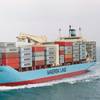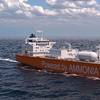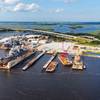By NAVSEA Corporate Communications
2007 was another successful year for the Naval Sea Systems Command’s (NAVSEA) Engineering for Reduced Maintenance (EFRM) team, with the warfighter-focused program making great strides in reducing shipboard maintenance burdens.
Working under NAVSEA’s Naval Systems Engineering Directorate, the EFRM team seeks to streamline costly and time-consuming maintenance procedures in the Fleet.
At January’s Surface Navy Symposium, NAVSEA Commander, Vice Adm. Paul E. Sullivan, talked about the importance maintenance plays in achieving NAVSEA’s mission.
“We can’t just build the new ships we need for the 313-ship Navy and go home,” said Sullivan. “We also need to make sure that we maintain the ships we have and that we keep them operational until the end of their service lives.”
Whether reducing significant Fleet maintenance costs, solving warfighter safety issues, or institutionalizing a number of solutions to create considerable labor and cost savings, EFRM initiatives continue to streamline maintenance procedures and support increased Fleet readiness.
Major initiatives introduced by the EFRM team that continue to pay dividends include Tank and Void Coating, Night Vision Imaging Systems (NVIS), Well Deck Lighting and the Electrical Systems initiative.
Corrosion issues significantly impact the Navy’s budget, and with maintenance painting topping the list of corrosion solutions, reducing painting requirements has the potential to save Fleet Sailors time and commanding officers important maintenance dollars.
The Tank and Void Coating initiative extends the coating service life in shipboard tanks and voids. The current life expectancy of traditional solvent-based coating systems ranges from three to five years, and the Tank and Voids Coating initiative is currently evaluating a rapid-cure, high-solids coatings solution, which is projected to last up to 20 years. Using the expected lifecycle of 20 years for the rapid-cure, high-solids coatings, the cost avoidance averages $12,000 per tank. That means a 20-year projected savings of $1.8 billion for surface ships.
“The Tank and Void Coating team has invested an extraordinary amount of time and effort into finding the best solution at the best cost for the Fleet, just like all of our EFRM initiatives,” said Vernon Parrish, EFRM program manager. “We know that the Sailors fighting the global war on terrorism are our number one customer, and we take that charge seriously as we seek to reduce tedious shipboard maintenance burdens.”
One of those burdens was eliminated with the Well Deck Dual Function Lighting initiative, currently being tested aboard USS Wasp (LHD 1). The EFRM team identified a type of light used for nighttime operations that required frequent change-outs following any contact with moisture from seawater. Replacing the bulbs with new LED lights allows two key improvements. The LED lights provide Sailors and Marines better visibility when conducting joint air and sea operations using night vision equipment; also, the LED lights stand up much better in the seawater environment, significantly reducing the frequency of bulb change-outs.
In addition to providing a safer environment for Sailors and Marines when conducting nighttime operations, this solution also offers an estimated $280,000 per year in maintenance savings per ship.
The EFRM team also found a significant maintenance savings aboard aircraft carriers in the operation of weapons elevators. The Programmable Logic Controller (PLC) initiative replaced the unreliable direct static logic and relay control systems with PLCs. The PLC offers many advantages over its counterparts, including less complex installations and a software-driven application program that reduces the initial fabrication and alternation costs associated with hard-wired systems.
Currently installed on CVN 71 through CVN 75 weapons elevators, the estimated cost savings for the PLC installations reduced annual maintenance tasks from an average of 130 man-hours per elevator with the old SEM-based controller, to 10 man-hours per elevator, per year for the new PLC systems. This equates to annual cost savings of $220,000 per ship.
“We are always in search of an optimum shipboard maintenance solution,” said Parrish, whose EFRM team continues to innovate maintenance procedures throughout the Fleet.
Featured videos

Send in the Drones (to deep, dark, confined maritime spaces)

Taking the First Step Toward Autonomy
Subscribe for
Maritime Reporter E-News
Maritime Reporter E-News is the maritime industry's largest circulation and most authoritative ENews Service, delivered to your Email five times per week











